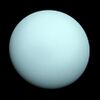Portia (moon)
Topic: Astronomy
 From HandWiki - Reading time: 3 min
From HandWiki - Reading time: 3 min
 | |
| Discovery | |
|---|---|
| Discovered by | Stephen P. Synnott / Voyager 2 |
| Discovery date | January 3, 1986 |
| Designations | |
Designation | Uranus XII |
| Pronunciation | /ˈpɔːrʃə/[1] |
| Adjectives | Portian /ˈpɔːrʃən/[1] |
| Orbital characteristics | |
| 66,097.265 ± 0.050 km[2] | |
| Eccentricity | 0.00005 ± 0.00008[2] |
| Orbital period | 0.5131959201 ± 0.0000000093 d[2] |
| Average Orbital speed | 9.37 km/s[lower-alpha 1] |
| Inclination | 0.05908 ± 0.039° (to Uranus' equator)[2] |
| Satellite of | Uranus |
| Group | ring shepherd |
| Physical characteristics | |
| Dimensions | 156 × 126 × 126 km[3] |
| Mean radius | 67.6 ± 4 km[3][4][5] |
| Surface area | ~57,000 km2[lower-alpha 1] |
| Volume | ~1,300,000 km3[lower-alpha 1] |
| Mass | ~1.7×1018 kg[lower-alpha 1] |
| Mean density | ~1.3 g/cm3 (assumed)[4] |
| ~0.023 m/s2[lower-alpha 1] | |
| ~0.058 km/s[lower-alpha 1] | |
| Rotation period | synchronous[3] |
| Axial tilt | zero[3] |
| Albedo | |
| Physics | ~64 K |
Portia is an inner satellite of Uranus. It was discovered from the images taken by Voyager 2 on 3 January 1986, and was given the temporary designation S/1986 U 1.[7] The moon is named after Portia, the heroine of William Shakespeare's play The Merchant of Venice. It is also designated Uranus XII.[8]
Portia is the second-largest inner satellite of Uranus after Puck. The Portian orbit, which lies inside Uranus' synchronous orbital radius, is slowly decaying due to tidal deceleration. The moon will one day either break up into a planetary ring or hit Uranus.
It heads a group of satellites called the Portia Group, which includes Bianca, Cressida, Desdemona, Juliet, Rosalind, Cupid, Belinda and Perdita.[6] These satellites have similar orbits and photometric properties.[6]
Little is known about Portia beyond its size of about 140 kilometres (87 mi) in diameter,[3] orbit,[2] and geometric albedo of about 0.08.[6]
In the Voyager 2 images, Portia appears as an elongated object whose major axis points towards Uranus. The ratio of axes of the Portia's prolate spheroid is 0.8 ± 0.1.[3] Its surface is grey in color.[3] Observations with Hubble Space Telescope and large terrestrial telescopes found water ice absorption features in the spectrum of Portia.[6][9]
Gallery
See also
References
Explanatory notes
Citations
- ↑ 1.0 1.1 Portia (3rd ed.), Oxford University Press, September 2005, http://oed.com/search?searchType=dictionary&q=Portia (Subscription or UK public library membership required.)
- ↑ 2.0 2.1 2.2 2.3 2.4 Jacobson, R. A. (1998). "The Orbits of the Inner Uranian Satellites From Hubble Space Telescope and Voyager 2 Observations". The Astronomical Journal 115 (3): 1195–1199. doi:10.1086/300263. Bibcode: 1998AJ....115.1195J.
- ↑ 3.0 3.1 3.2 3.3 3.4 3.5 3.6 Karkoschka, Erich (2001). "Voyager's Eleventh Discovery of a Satellite of Uranus and Photometry and the First Size Measurements of Nine Satellites". Icarus 151 (1): 69–77. doi:10.1006/icar.2001.6597. Bibcode: 2001Icar..151...69K.
- ↑ 4.0 4.1 4.2 "Planetary Satellite Physical Parameters". JPL (Solar System Dynamics). 2008-10-24. http://ssd.jpl.nasa.gov/?sat_phys_par.
- ↑ 5.0 5.1 Williams, Dr. David R. (2007-11-23). "Uranian Satellite Fact Sheet". NASA (National Space Science Data Center). http://nssdc.gsfc.nasa.gov/planetary/factsheet/uraniansatfact.html.
- ↑ 6.0 6.1 6.2 6.3 6.4 Karkoschka, Erich (2001). "Comprehensive Photometry of the Rings and 16 Satellites of Uranus with the Hubble Space Telescope". Icarus 151 (1): 51–68. doi:10.1006/icar.2001.6596. Bibcode: 2001Icar..151...51K.
- ↑ Smith, B. A. (January 16, 1986). "Satellites of Uranus". IAU Circular 4164. http://www.cbat.eps.harvard.edu/iauc/04100/04164.html#Item1. Retrieved 29 October 2011.
- ↑ "Planet and Satellite Names and Discoverers". Gazetteer of Planetary Nomenclature. USGS Astrogeology. July 21, 2006. http://planetarynames.wr.usgs.gov/Page/Planets.
- ↑ Dumas, Christophe; Smith, Bradford A.; Terrile, Richard J. (2003). "Hubble Space Telescope NICMOS Multiband Photometry of Proteus and Puck". The Astronomical Journal 126 (2): 1080–1085. doi:10.1086/375909. Bibcode: 2003AJ....126.1080D.
External links
 |
 KSF
KSF


